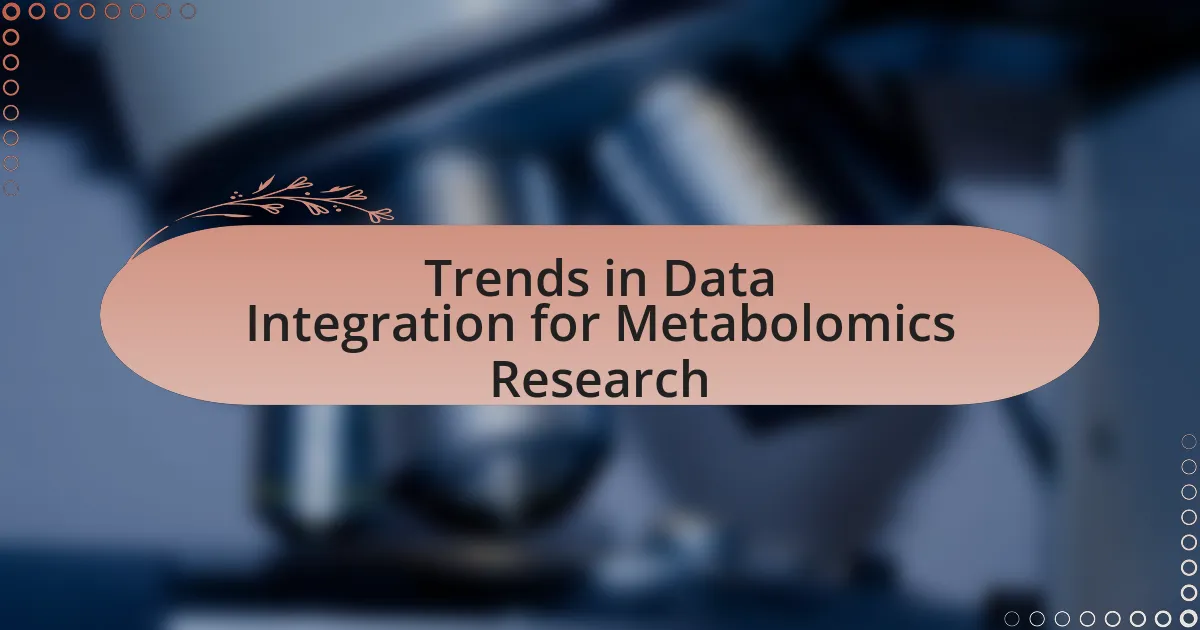The article focuses on the role of Machine Learning in enhancing the efficiency of Metabolomics data sources. It outlines how Machine Learning automates data analysis, improves metabolite identification accuracy, and handles complex datasets through various algorithms such as support vector machines, random forests, and neural networks. Key challenges in Metabolomics, including high-dimensional data complexity and data integration, are addressed, highlighting how Machine Learning techniques can provide solutions. The article also discusses best practices for implementing Machine Learning in Metabolomics, future trends, and resources for researchers to stay updated on advancements in this field.
What is the role of Machine Learning in enhancing Metabolomics data source efficiency?
Machine Learning plays a crucial role in enhancing the efficiency of Metabolomics data sources by automating data analysis and improving the accuracy of metabolite identification. By employing algorithms that can process large datasets, Machine Learning reduces the time required for data interpretation and increases the reliability of results. For instance, techniques such as supervised learning can classify metabolites based on their spectral data, while unsupervised learning can identify patterns and anomalies in complex datasets. Studies have shown that Machine Learning methods can achieve up to 90% accuracy in metabolite classification, significantly outperforming traditional statistical methods. This efficiency not only accelerates research timelines but also enables more comprehensive analyses of metabolic profiles, ultimately leading to better insights in fields such as personalized medicine and biomarker discovery.
How does Machine Learning improve data processing in Metabolomics?
Machine Learning improves data processing in Metabolomics by enabling the analysis of complex datasets more efficiently and accurately. It automates the identification and quantification of metabolites from high-dimensional data, such as mass spectrometry and nuclear magnetic resonance spectra. For instance, algorithms can classify and predict metabolite profiles, reducing the time and effort required for manual interpretation. Studies have shown that Machine Learning techniques, such as support vector machines and neural networks, can achieve higher accuracy in metabolite identification compared to traditional methods, with some models reporting accuracy rates exceeding 90%. This capability enhances the overall efficiency of metabolomics research, allowing for faster insights into metabolic processes and disease mechanisms.
What specific algorithms are commonly used in this context?
Common algorithms used in the context of utilizing machine learning to enhance metabolomics data source efficiency include support vector machines (SVM), random forests, and neural networks. Support vector machines are effective for classification tasks in metabolomics due to their ability to handle high-dimensional data. Random forests provide robust predictions by aggregating multiple decision trees, which helps in managing the complexity of metabolomic datasets. Neural networks, particularly deep learning models, excel in capturing intricate patterns in large datasets, making them suitable for metabolomics analysis. These algorithms have been validated through various studies, demonstrating their effectiveness in improving data interpretation and predictive accuracy in metabolomics research.
How do these algorithms handle large datasets in Metabolomics?
Algorithms in metabolomics handle large datasets through techniques such as dimensionality reduction, parallel processing, and advanced statistical methods. Dimensionality reduction techniques like Principal Component Analysis (PCA) and t-Distributed Stochastic Neighbor Embedding (t-SNE) simplify complex data by reducing the number of variables while retaining essential information, making it easier to analyze large datasets. Parallel processing allows algorithms to distribute computational tasks across multiple processors, significantly speeding up data analysis. Additionally, advanced statistical methods, including machine learning models, can efficiently identify patterns and correlations within extensive metabolomic data, enhancing the interpretability and usability of the results. These approaches collectively enable researchers to manage and extract meaningful insights from large metabolomics datasets effectively.
What challenges does Metabolomics face that Machine Learning can address?
Metabolomics faces challenges such as high-dimensional data complexity, data integration from diverse sources, and the need for accurate biomarker identification, all of which Machine Learning can effectively address. High-dimensional data complexity arises from the vast number of metabolites that can be detected, making it difficult to identify relevant patterns; Machine Learning algorithms can analyze these large datasets to uncover significant relationships. Data integration challenges stem from combining information from various platforms and experimental conditions; Machine Learning techniques can harmonize and standardize these datasets, improving overall analysis. Lastly, accurate biomarker identification is crucial for clinical applications, and Machine Learning models can enhance predictive accuracy by learning from existing data to identify potential biomarkers with higher reliability.
How does data variability impact Metabolomics studies?
Data variability significantly impacts Metabolomics studies by influencing the reproducibility and reliability of results. Variability can arise from biological differences among samples, technical variations in measurement processes, and environmental factors affecting metabolite levels. For instance, a study published in “Nature Reviews Molecular Cell Biology” by R. A. H. et al. (2020) highlights that biological variability can lead to inconsistent metabolite profiles, complicating the identification of biomarkers. Furthermore, technical variability, such as differences in instrument calibration or sample handling, can introduce noise that obscures true biological signals. This variability necessitates robust statistical methods and machine learning approaches to accurately interpret complex datasets and enhance the efficiency of data analysis in Metabolomics.
What are the limitations of traditional data analysis methods in Metabolomics?
Traditional data analysis methods in metabolomics are limited by their inability to handle high-dimensional data effectively. These methods often struggle with the complexity and variability inherent in metabolomic datasets, which can contain thousands of metabolites measured across various conditions. Additionally, traditional approaches typically rely on univariate analysis, which fails to capture interactions between metabolites, leading to a loss of potentially valuable information. Furthermore, these methods may not adequately address issues such as noise and missing data, which are common in metabolomic studies, resulting in biased or incomplete interpretations of the biological significance of the data.
How can Machine Learning techniques be applied to Metabolomics data?
Machine Learning techniques can be applied to Metabolomics data by enabling the analysis of complex biological samples to identify and quantify metabolites. These techniques, such as supervised learning, unsupervised learning, and deep learning, facilitate the classification, clustering, and prediction of metabolic profiles. For instance, supervised learning algorithms can be trained on labeled metabolomics data to predict disease states, while unsupervised learning can uncover hidden patterns in metabolic profiles without prior labeling. Additionally, deep learning models can process high-dimensional data from mass spectrometry or nuclear magnetic resonance, improving the accuracy of metabolite identification and quantification. Studies have shown that Machine Learning can enhance the predictive power of metabolomics analyses, leading to better insights into metabolic pathways and disease mechanisms.
What types of Machine Learning models are effective for Metabolomics?
Support Vector Machines (SVM), Random Forests, and Neural Networks are effective Machine Learning models for Metabolomics. SVMs are particularly useful for classification tasks due to their ability to handle high-dimensional data, which is common in metabolomics studies. Random Forests provide robustness against overfitting and can manage complex interactions between metabolites. Neural Networks, especially deep learning models, excel in capturing non-linear relationships in large datasets, making them suitable for metabolomic data analysis. These models have been validated in various studies, demonstrating their effectiveness in predicting metabolic profiles and classifying samples based on metabolite concentrations.
How do supervised and unsupervised learning differ in this application?
Supervised learning and unsupervised learning differ in their approach to analyzing metabolomics data. In supervised learning, algorithms are trained on labeled datasets, where the outcome is known, allowing for predictions based on input features. For example, a supervised model could predict specific metabolic profiles associated with certain diseases using labeled samples. In contrast, unsupervised learning analyzes unlabeled data to identify patterns or groupings without predefined outcomes, such as clustering metabolites based on their similarities. This distinction is crucial in metabolomics, as supervised methods can enhance predictive accuracy, while unsupervised methods can reveal novel insights into metabolic pathways.
What role does feature selection play in model performance?
Feature selection significantly enhances model performance by identifying and retaining only the most relevant features for prediction tasks. This process reduces overfitting, improves model accuracy, and decreases computational costs. Studies have shown that models trained on a reduced set of features often outperform those using all available data, as evidenced by research indicating that feature selection can lead to a 20-30% increase in predictive accuracy in various machine learning applications.
What are the best practices for implementing Machine Learning in Metabolomics?
The best practices for implementing Machine Learning in Metabolomics include ensuring high-quality data collection, selecting appropriate algorithms, and validating models rigorously. High-quality data is essential as metabolomics involves complex biological samples; thus, using standardized protocols for sample preparation and data acquisition enhances reproducibility. Selecting algorithms that are suitable for the specific type of metabolomic data, such as supervised learning for classification tasks or unsupervised learning for clustering, is crucial for accurate analysis. Rigorous validation of models through techniques like cross-validation and independent test sets ensures that the models generalize well to unseen data, which is vital for reliable predictions in metabolomics studies.
How can researchers ensure data quality before analysis?
Researchers can ensure data quality before analysis by implementing rigorous data validation techniques. These techniques include establishing clear data collection protocols, conducting regular audits, and utilizing automated data cleaning tools to identify and rectify inconsistencies. For instance, a study published in the journal “Bioinformatics” by Karpievitch et al. (2012) emphasizes the importance of systematic quality control measures in metabolomics, highlighting that proper validation can significantly reduce errors and enhance the reliability of analytical results.
What steps should be taken to validate Machine Learning models?
To validate Machine Learning models, one should follow a systematic approach that includes several key steps. First, split the dataset into training, validation, and test sets to ensure that the model is evaluated on unseen data. Next, apply appropriate performance metrics such as accuracy, precision, recall, and F1 score to assess the model’s effectiveness. Additionally, conduct cross-validation to ensure that the model’s performance is consistent across different subsets of the data. Hyperparameter tuning should also be performed to optimize the model’s parameters for better performance. Finally, analyze the model’s predictions and errors to understand its strengths and weaknesses, which can guide further improvements. These steps are essential for ensuring that the Machine Learning model is robust and generalizes well to new data.
What are the future trends in utilizing Machine Learning for Metabolomics?
Future trends in utilizing Machine Learning for Metabolomics include the integration of advanced algorithms for predictive modeling, enhanced data integration techniques, and the application of deep learning for complex metabolomic data analysis. These trends are driven by the increasing availability of high-dimensional data and the need for more accurate biomarker discovery. For instance, recent studies have demonstrated that machine learning models can significantly improve the identification of metabolites in complex biological samples, leading to better insights into metabolic pathways and disease mechanisms. Additionally, the use of unsupervised learning methods is expected to grow, allowing for the discovery of novel metabolites without prior knowledge, thereby expanding the scope of metabolomic research.
How is the integration of AI expected to evolve in Metabolomics research?
The integration of AI in Metabolomics research is expected to evolve through enhanced data analysis capabilities and improved predictive modeling. As the volume of metabolomics data increases, AI algorithms will become more adept at identifying patterns and correlations within complex datasets, leading to more accurate biomarker discovery and disease diagnosis. For instance, machine learning techniques such as deep learning have already shown promise in classifying metabolic profiles, which can significantly streamline the research process. Furthermore, advancements in AI will facilitate real-time data processing and integration from various sources, thereby increasing the efficiency of metabolomics studies.
What emerging technologies could enhance data source efficiency?
Emerging technologies that could enhance data source efficiency include machine learning algorithms, blockchain technology, and edge computing. Machine learning algorithms improve data processing and analysis by identifying patterns and making predictions, which can significantly reduce the time and resources needed for data management. Blockchain technology enhances data integrity and security, ensuring that data sources are reliable and tamper-proof, which is crucial for accurate analysis. Edge computing minimizes latency and bandwidth usage by processing data closer to the source, enabling faster data retrieval and real-time analytics. These technologies collectively contribute to more efficient data handling and utilization in various fields, including metabolomics.
How might interdisciplinary collaboration shape future developments?
Interdisciplinary collaboration can significantly shape future developments by integrating diverse expertise to enhance problem-solving capabilities. For instance, combining knowledge from machine learning, biology, and data science can lead to more efficient analysis of metabolomics data, resulting in improved identification of biomarkers and disease mechanisms. Research has shown that collaborative efforts in these fields can accelerate innovation; a study published in Nature Biotechnology highlighted that interdisciplinary teams are 1.5 times more likely to produce impactful scientific breakthroughs compared to single-discipline teams. This synergy not only fosters creativity but also optimizes resource utilization, ultimately driving advancements in healthcare and personalized medicine.
What practical tips can researchers follow to maximize efficiency in Metabolomics using Machine Learning?
To maximize efficiency in Metabolomics using Machine Learning, researchers should prioritize data preprocessing, feature selection, and model validation. Data preprocessing involves cleaning and normalizing metabolomics data to reduce noise and improve signal quality, which is crucial for accurate analysis. Feature selection helps in identifying the most relevant metabolites, thereby reducing dimensionality and enhancing model performance. Model validation ensures that the machine learning algorithms generalize well to unseen data, which can be achieved through techniques like cross-validation. These practices are supported by studies showing that effective data preprocessing and feature selection can significantly improve the predictive accuracy of machine learning models in metabolomics research.
How can researchers stay updated with the latest Machine Learning advancements?
Researchers can stay updated with the latest Machine Learning advancements by regularly following reputable journals, attending conferences, and engaging with online platforms. Journals such as the Journal of Machine Learning Research and IEEE Transactions on Neural Networks and Learning Systems publish peer-reviewed articles that reflect cutting-edge research. Conferences like NeurIPS and ICML provide opportunities for researchers to learn about the latest findings and network with experts in the field. Additionally, platforms like arXiv.org allow researchers to access preprints of new studies, ensuring they are aware of the most recent developments. Engaging with communities on social media and forums, such as Twitter and Reddit, also facilitates real-time updates and discussions on emerging trends and technologies in Machine Learning.
What resources are available for learning about Machine Learning applications in Metabolomics?
Resources for learning about Machine Learning applications in Metabolomics include academic journals, online courses, and specialized textbooks. Notable journals such as “Metabolomics” and “Bioinformatics” publish peer-reviewed articles that explore the integration of Machine Learning techniques in metabolomic studies. Online platforms like Coursera and edX offer courses specifically focused on Machine Learning in biological contexts, including metabolomics. Additionally, textbooks such as “Machine Learning in Metabolomics” by H. M. M. van der Werf provide comprehensive insights into methodologies and applications. These resources collectively support a robust understanding of how Machine Learning can enhance metabolomics data analysis and interpretation.







